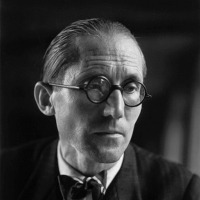Wrightwood 659 is Tadao Ando’s second project in the city for the same client. The 3.250-square-meter gallery is located just next door his first project, a house for philanthropist and activist Fred Eychaner completed twenty years ago in the Lincoln Park neighborhood.
The exterior, a perimeter masonry shell of the red brick was renovated; and it is only when the visitor go into when he discovers Ando's hand visible in the new structure. There, a poured concrete stair tower, positioned at an angle, is a sharp contrast to the tan-colored common brick—salvaged from the original structure—that line the walls of the atrium.
The project also has a structure on the rooftop, set back from the perimeter, which provide a terrace for exhibitions and for viewing the city skyline.
The exhibition occupies all three floors of exhibition space at Wrightwood 659. It includes more than 100 Le Corbusier drawings, photographs, and models—on loan from institutions including the Fondation Le Corbusier, Paris, and the Art Institute of Chicago—as well as 106 small models of Le Corbusier’s architectural works made by students of Ando, among other objects. The curator of the Le Corbusier section of the exhibition is Eric Mumford, PhD, Rebecca and John Voyles Professor of Architecture, Washington University in St. Louis. The Ando section is curated by architectural historian Dan Whittaker, PhD, who is working with the Ando studio on the installation of that portion of the exhibition. The exhibition is sponsored by Alphawood Exhibitions LLC.
Wrightwood 659 was founded by Fred Eychaner and Dan Whittaker. Eychaner is a longtime LGBTQ activist, philanthropist, and president of Alphawood Foundation Chicago. Whittaker, who is co-curator of the inaugural exhibition, served as owner’s representative for construction of Wrightwood 659, and as liaison with Tadao Ando Architects.
Alphawood is a grant-making foundation committed primarily to advocacy, architecture and preservation, arts and arts education, promotion and protection of the rights of LGBT citizens and people living with HIV/AIDS, and other human and civil rights. James D. McDonough is executive director and general counsel of Alphawood. The Foundation was lead donor to Louis Kahn’s Four Freedoms Park on Roosevelt Island in New York City, and spearheaded the renovation of Frank Lloyd Wright’s Unity Temple in Oak Park, Illinois.


















































